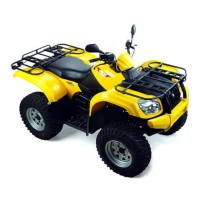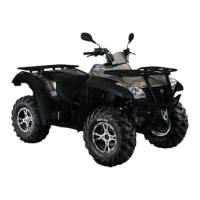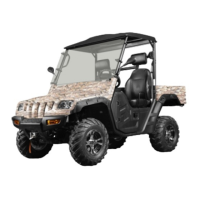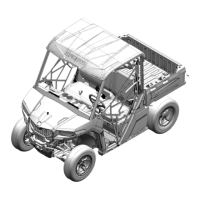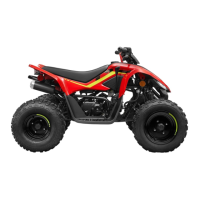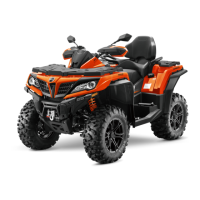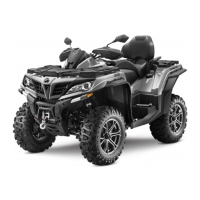Do you have a question about the CF MOTO CF500ATR-2L and is the answer not in the manual?
Greeting and introduction to the CFMOTO brand and community.
Explanation of warning symbols (Warning, Caution, Note) used throughout the manual.
Details on locating and recording the vehicle's VIN and model/serial numbers.
Technical specifications and dimensions for different vehicle models.
Specifies the minimum age requirement for operating the vehicle.
Emphasizes operator responsibility for personal safety and vehicle knowledge.
Advises against modifications that could affect speed or power, voiding warranty.
Warns about hot components during and after operation to prevent burns.
Guidelines and precautions for towing a trailer with the vehicle.
Recommends hands-on training and familiarization with laws and regulations.
Lists critical warnings for safe operation, including proper instruction and gear.
Details essential protective gear like helmets, eye protection, gloves, boots, and clothing.
Explains the importance of warning decals and their locations on the vehicle.
Description of controls on the left handlebar, including override and headlight switches.
Description of controls on the right handlebar, including front brake and drive system switches.
Details on the foot brake pedal and its fluid reservoir.
Highlights key vehicle features like the main switch and fuel tank.
Explanation of the Continuously Variable Transmission (CVT) system and its components.
Advice on preventing damage to the CVT drive belt and components through proper use.
Explanation of various indicators and warning lights on the dashboard.
Details on the speedometer, fuel gauge, and other information displayed on the dashboard.
Instructions for the initial break-in period to ensure engine efficiency and longevity.
Essential checks to perform before operating the vehicle for safety and readiness.
Step-by-step guide on how to start the vehicle's engine safely.
Instructions on how to shift gears, including Park, Neutral, Reverse, and drive modes.
Guidelines and precautions for safely hauling or towing cargo with the vehicle.
Advice on proper weight distribution for carrying loads and trailers.
General principles and responsibilities for safe vehicle operation.
Emphasizes practicing driving procedures at low speeds to build proficiency.
Basic steps for operating the vehicle, including posture and throttle control.
Techniques for making safe and effective turns, including body positioning.
Explanation of how vehicle dynamics affect turning, especially in 4WD-LOCK mode.
Specific procedures and precautions for operating the vehicle in reverse.
Precautions and techniques for safe driving on wet trails, gravel, or ice.
Guidance for navigating trails with rocks, obstacles, and uneven surfaces.
Procedures for safely operating the vehicle through water crossings.
Precautions and techniques for safe travel on inclines and steep hills.
Safety measures and techniques for descending hills, including speed control.
Maneuver for turning the vehicle around when stranded on a hill.
Procedures for safely parking the vehicle on an incline.
Importance of following the maintenance schedule for safety and reliability.
Defines conditions considered "severe use" and its impact on maintenance intervals.
Explains maintenance intervals and special icon key for service items.
Checklist of essential inspections before operating the vehicle.
Maintenance items to perform after the vehicle's break-in period is completed.
Detailed schedule for periodic maintenance intervals based on hours, calendar, and miles.
Procedure for checking and maintaining the correct engine oil level.
Step-by-step guide for changing the engine oil and oil filter.
Instructions for replacing the oil filter cartridge.
Procedure for checking and changing the rear gear case oil.
Procedure for checking and changing the front gear case oil.
Information on coolant level inspection and system maintenance.
Details on spark plug inspection, gap adjustment, and replacement.
Guidance on air filter inspection, cleaning, and replacement for optimal performance.
Procedures for inspecting and maintaining brake pads, discs, and fluid levels.
Instructions for inspecting and lubricating control cables for smooth operation.
Maintenance and adjustment procedures for the vehicle's front and rear suspension.
Steps for wheel removal, installation, tire pressure, and tread depth checks.
Guidelines for battery maintenance, charging, and connection.
Information on head light assembly, adjustment, and replacement procedures.
Location and replacement procedures for fuses and relays.
Proper methods for cleaning the vehicle to maintain appearance and component life.
Recommendations for waxing the vehicle to protect its finish.
Importance of making necessary repairs before storing the vehicle.
Instructions for inspecting tire treads and setting correct air pressure.
Guidance on changing the engine oil and filter before storage.
Procedures for inspecting and cleaning the air filter and air box.
Instructions for checking and changing various fluid levels before storage.
Method for stabilizing fuel to prevent degradation during storage.
Procedures for removing and storing the battery properly.
Recommendations for lubricating cables and pivot points before storage.
Process for fogging the engine with oil to protect internal components during storage.
Advice on selecting a suitable storage area and covering the vehicle.
Procedures for safely securing and transporting the vehicle.
Possible causes and solutions for an engine that fails to crank.
Identifies potential reasons for engine knocking or pinging and their solutions.
Troubleshooting steps for issues related to the engine stopping or losing power.
Diagnosis and solutions for when the engine cranks but does not start.
Common causes and remedies for engine backfiring issues.
Troubleshooting steps for an engine that runs unevenly, stalls, or misfires.
Explanation of the Electronic Fuel Injection malfunction indicator light and its meaning.
Information on the Electronic Power Steering malfunction indicator and troubleshooting.
Table detailing common EPS system faults, probable reasons, and troubleshooting steps.
Specifies noise emission levels and test methods for different vehicle variants.
Presents vibration data measured during standard roadway tests for driver comfort.
Requirements for vehicle registration to ensure warranty coverage.
Lists conditions and damages that are not covered by the limited warranty.
Details the duration of the warranty for private and commercial use.
Outlines limitations on implied warranties and exclusions from coverage.
Specifies the conditions that must be met to ensure warranty coverage.
Procedures for obtaining warranty service and customer responsibilities.
Outlines the responsibilities of authorized CFMOTO dealers for warranty repairs.
Information regarding warranty coverage for products sold outside the authorized dealer's country.
Greeting and introduction to the CFMOTO brand and community.
Explanation of warning symbols (Warning, Caution, Note) used throughout the manual.
Details on locating and recording the vehicle's VIN and model/serial numbers.
Technical specifications and dimensions for different vehicle models.
Specifies the minimum age requirement for operating the vehicle.
Emphasizes operator responsibility for personal safety and vehicle knowledge.
Advises against modifications that could affect speed or power, voiding warranty.
Warns about hot components during and after operation to prevent burns.
Guidelines and precautions for towing a trailer with the vehicle.
Recommends hands-on training and familiarization with laws and regulations.
Lists critical warnings for safe operation, including proper instruction and gear.
Details essential protective gear like helmets, eye protection, gloves, boots, and clothing.
Explains the importance of warning decals and their locations on the vehicle.
Description of controls on the left handlebar, including override and headlight switches.
Description of controls on the right handlebar, including front brake and drive system switches.
Details on the foot brake pedal and its fluid reservoir.
Highlights key vehicle features like the main switch and fuel tank.
Explanation of the Continuously Variable Transmission (CVT) system and its components.
Advice on preventing damage to the CVT drive belt and components through proper use.
Explanation of various indicators and warning lights on the dashboard.
Details on the speedometer, fuel gauge, and other information displayed on the dashboard.
Instructions for the initial break-in period to ensure engine efficiency and longevity.
Essential checks to perform before operating the vehicle for safety and readiness.
Step-by-step guide on how to start the vehicle's engine safely.
Instructions on how to shift gears, including Park, Neutral, Reverse, and drive modes.
Guidelines and precautions for safely hauling or towing cargo with the vehicle.
Advice on proper weight distribution for carrying loads and trailers.
General principles and responsibilities for safe vehicle operation.
Emphasizes practicing driving procedures at low speeds to build proficiency.
Basic steps for operating the vehicle, including posture and throttle control.
Techniques for making safe and effective turns, including body positioning.
Explanation of how vehicle dynamics affect turning, especially in 4WD-LOCK mode.
Specific procedures and precautions for operating the vehicle in reverse.
Precautions and techniques for safe driving on wet trails, gravel, or ice.
Guidance for navigating trails with rocks, obstacles, and uneven surfaces.
Procedures for safely operating the vehicle through water crossings.
Precautions and techniques for safe travel on inclines and steep hills.
Safety measures and techniques for descending hills, including speed control.
Maneuver for turning the vehicle around when stranded on a hill.
Procedures for safely parking the vehicle on an incline.
Importance of following the maintenance schedule for safety and reliability.
Defines conditions considered "severe use" and its impact on maintenance intervals.
Explains maintenance intervals and special icon key for service items.
Checklist of essential inspections before operating the vehicle.
Maintenance items to perform after the vehicle's break-in period is completed.
Detailed schedule for periodic maintenance intervals based on hours, calendar, and miles.
Procedure for checking and maintaining the correct engine oil level.
Step-by-step guide for changing the engine oil and oil filter.
Instructions for replacing the oil filter cartridge.
Procedure for checking and changing the rear gear case oil.
Procedure for checking and changing the front gear case oil.
Information on coolant level inspection and system maintenance.
Details on spark plug inspection, gap adjustment, and replacement.
Guidance on air filter inspection, cleaning, and replacement for optimal performance.
Procedures for inspecting and maintaining brake pads, discs, and fluid levels.
Instructions for inspecting and lubricating control cables for smooth operation.
Maintenance and adjustment procedures for the vehicle's front and rear suspension.
Steps for wheel removal, installation, tire pressure, and tread depth checks.
Guidelines for battery maintenance, charging, and connection.
Information on head light assembly, adjustment, and replacement procedures.
Location and replacement procedures for fuses and relays.
Proper methods for cleaning the vehicle to maintain appearance and component life.
Recommendations for waxing the vehicle to protect its finish.
Importance of making necessary repairs before storing the vehicle.
Instructions for inspecting tire treads and setting correct air pressure.
Guidance on changing the engine oil and filter before storage.
Procedures for inspecting and cleaning the air filter and air box.
Instructions for checking and changing various fluid levels before storage.
Method for stabilizing fuel to prevent degradation during storage.
Procedures for removing and storing the battery properly.
Recommendations for lubricating cables and pivot points before storage.
Process for fogging the engine with oil to protect internal components during storage.
Advice on selecting a suitable storage area and covering the vehicle.
Procedures for safely securing and transporting the vehicle.
Possible causes and solutions for an engine that fails to crank.
Identifies potential reasons for engine knocking or pinging and their solutions.
Troubleshooting steps for issues related to the engine stopping or losing power.
Diagnosis and solutions for when the engine cranks but does not start.
Common causes and remedies for engine backfiring issues.
Troubleshooting steps for an engine that runs unevenly, stalls, or misfires.
Explanation of the Electronic Fuel Injection malfunction indicator light and its meaning.
Information on the Electronic Power Steering malfunction indicator and troubleshooting.
Table detailing common EPS system faults, probable reasons, and troubleshooting steps.
Specifies noise emission levels and test methods for different vehicle variants.
Presents vibration data measured during standard roadway tests for driver comfort.
Requirements for vehicle registration to ensure warranty coverage.
Lists conditions and damages that are not covered by the limited warranty.
Details the duration of the warranty for private and commercial use.
Outlines limitations on implied warranties and exclusions from coverage.
Specifies the conditions that must be met to ensure warranty coverage.
Procedures for obtaining warranty service and customer responsibilities.
Outlines the responsibilities of authorized CFMOTO dealers for warranty repairs.
Information regarding warranty coverage for products sold outside the authorized dealer's country.
| Brand | CF MOTO |
|---|---|
| Model | CF500ATR-2L |
| Category | Offroad Vehicle |
| Language | English |
